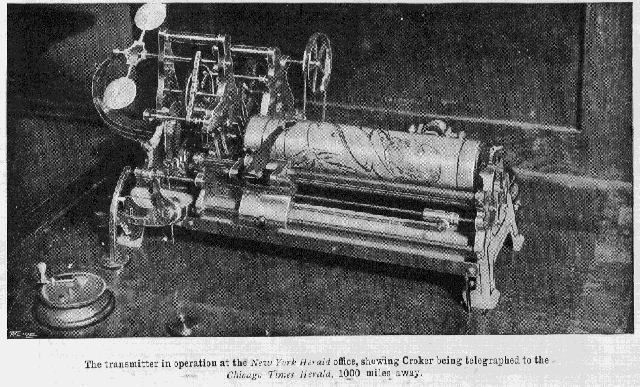|
Hummel's Telediagraph, 1898
In 1898, the New York Herald experimented with the Hummel system of picture telegraphy, and sinve then the same journal has made experiments with an improved form of the Hummel apparatus.
The apparatus, as described in the Telegraph Age, consists of a receiver and transmitter, which are similar in appearance and mechanism. The picture to be transmitted is drawn on a heavy piece of metal foil, the lines of the drawing being made with an insulatiting ink. The foil is then secured on the circumference of a horizontal cylinder of the transmitter, the cylinder being about the size of a typewriter rubber roller.
There is a similair cylinder on the receiver, upon whose surface is clamped the paper on which the drawing is to be produced; over this is superposed carbon paper, which is covered in turn by a sheet of thin paper.
The Telediagraph was one of several early fax-like devices sending pictures via telegraph lines. It was invented circa 1895 by Ernest A. Hummel, a watchmaker of St. Paul, Minnesota.
The first machines were installed in the office of the New York Herald in 1898. By 1899, Hummel had improved the machine and the newspaper had machines in the offices ofthe Chicago Times Herald, the St. Louis Republic, the Boston Herald, and the Philadelphia Inquirer.
The system used synchronised rotating 8-inch drums, with a platinum stylus used as an electrode in the transmitter. The original image was drawn on 8x6" tin-foil using a non-conducting ink made from shellac mixed with alcohol. The image was received on carbon paper wrapped between two sheets of blank paper. When the electrode touched the tin-foil in the transmitter the circuit was closed; when it touched the shellac the circuit was open.
The signal controlled a moving stylus in the receiver, making it touch or move back from the paper. At the end of each rotation a synchronising signal was sent, and the styluses in both machines moved 1/56" to the left before scanning the next line.
The first picture sent was "an accurate picture of the first gun fired at Manila." The machine took 20-30 minutes to send the picture.
Near-copies of this and similar mechanisms were in use until the 1970s, although transmission speeds were improved and photocells allowed plain paper originals and photographs to be transmitted. The basic principle was also applied to stencil-cutting machines for ink duplicators.
Article from Pearson's Magazine, April 1900
|
